Shrub
Ochna pulchra Hook.f.
Family:
Common names: peeling plane, peeling-bark ochna (Eng.); lekkerbreek (Afr.); monyelewyele (Tswana); monamane, mopha (Northern Sotho); musuma, murambo, tshithothonya ( Venda ); nzololo (Tso)
SA Tree No: 483
Plant Attributes:
Plant Type:
SA Distribution:
Soil type:
Flowering season:
PH:
Flower colour:
Aspect:
Gardening skill:
Special Features:
Horticultural zones
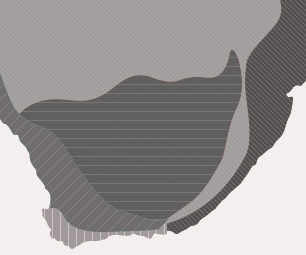
Ochna L.
Family:
Common names: wild planes, mickey-mouse plants
Species
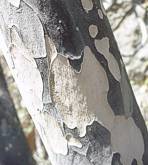
Ochna arborea Burch.ex DC. An evergreen shrub to medium-sized tree, up to 12 m high. The leaves are oblong, leathery and glossy green with serrated margins. The bright yellow flowers are borne in clusters, on short lateral shoots. Flowering time: Aug.-Jan. The ripe fruit consists of 1-5 kidney-shaped, shiny black carpels on an enlarged receptacle, inside the red, petal-like sepals. Fruiting time: Nov.-Feb. The plant occurs in Limpopo, Mpumalanga, KwaZulu-Natal and Eastern Cape, also in Swaziland, Zimbabwe and Mozambique.

O. arborea var. arborea. The leaves are smaller, 24–75 mm long, and slightly serrated to almost entire. The flower stalk is shorter, < 15 mm, and it grows in lowland and forest. The flowers of both varieties of O.arborea are similar.
.
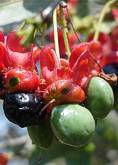
O. arborea var. oconnorii (E.Phillips) Du Toit. The leaves are larger, 68–170 mm long, and prominently serrated. The flower stalk is longer, > 20 mm. It grows in montane forest. The fruits of both varities of O.arborea are similar.

Ochna barbosae N.Robson. A shrub to small tree, 1–8 m, and found in woodland and grassland, on sandy soils along the coast. The leaves are alternate, 30–50 x 12–15 mm, leathery and with prominent green, net veins on both sides. The flowers are yellow and sweet-scented. Flowering time: Aug.–Sept. The fruit is pink to purple, with the spreading sepals of the enlarged calyx up to 15 mm long. There are 5–6 black drupelets. Fruiting time: Nov.–Jan. This lovely tree is found in Kwa Zulu-Natal, Zimbabwe and Mozambique.
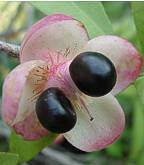
Image is of fruits of Ochna barbosae

Ochna confusa Burtt Davy & Greenway. A multi-stemmed shrub up to 2 m with long, slender, straight branches. The leaves are simple, narrowly elliptic and pale green with serrated margins. The up to six yellow flowers are borne in clusters on short spurs in the axil of a leaf. Flowering time: Aug.–Oct. The ripe fruit comprises of 5 separate round black drupes on a receptacle. Fruiting time: Sept.–Dec. The plant occurs on the hills of Mpumalanga and also Zambia, Zimbabwe, Malawi, Mozambique and Tanzania.

Ochna gamostigmata Du Toit. A shrub or rarely a tree up to 6 m high. The leaves are alternate, simple and elliptic to very narrowly elliptic with serrated margins. The yellow flowers are solitary or rarely in pairs. Flowering time: Sept.–Mar. The ripe fruit consists of 5 separate round drupes on a receptacle, almost enclosed in the red calyx. Fruiting time: Nov.–Mar. This plant occurs in Mpumalanga, KwaZulu-Natal, and Swaziland.
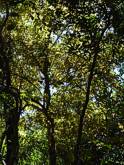
Ochna holstii Engl. A shrub to medium-sized tree, up to 15 m high, with rough, grey-brown stems and branchlets with scattered, pale raised dots. The leaves are alternate, 50–100 x 15–25 mm, with midrib and net veins prominent from above and serrated margins. The yellow flowers, in dense clusters of up to 10, grow on short side shoots. Flowering time: Sept.–Nov. Fruit pink to purple, enlarged calyx with spreading sepals up to 15 mm long, surrounds 5–6 black drupelets. Fruiting time: Nov.–Jan. The plant occurs in forests at altitudes from 900–1 700 m, in Limpopo, Mpumalanga, KwaZulu-Natal, Eastern Cape, and also in Swaziland, Zimbabwe and Mozambique.

Ochna inermis (Forssk.) Schweinf. A multi-stemmed shrub or small tree. The leaves are clustered on short spurs, elliptic to almost circular, 20–60 x 10–60 mm, with margins finely serrate. The yellow flowers are solitary or in pairs. Flowering time: Sept.–Nov. Fruit: 1–3 black drupes joined at their bases, enclosed by the red, persistent sepals. The plant occurs in Limpopo, North-West and Mpumalanga, also in Botswana, Zimbabwe and Mozambique.

Ochna natalitia (Meisn.)Walp. A small, evergreen multi-stemmed shrub found on rocky outcrops and in bushveld. The bark is dark and rough. The leaves are alternate, simple and elliptic, 50–200 x 10–45 mm, and dark green with the new leaves red in spring. The flowers, borne in a cluster, are large and golden yellow. Flowering time: Sept.–Dec. The plant is found in Limpopo, North-West, Gauteng, KwaZulu-Natal and Eastern Cape, and also in Swaziland, Zimbabwe and Mozambique. Read more about this plant.
Plant Attributes:
Plant Type:
SA Distribution:
Soil type:
Flowering season:
PH:
Flower colour:
Aspect:
Gardening skill:
Special Features:
Horticultural zones

Nymania capensis ( Thunb.) Lindb.
Family:
Common names: Chinese lanterns, Chinese lantern tree, kipkippers (Eng.); klapperbos, lanternbos, kiepkiepies, oumeidsbos, stuipebos (Afr.)
SA Tree No: 295
Plant Attributes:
Plant Type:
SA Distribution:
Soil type:
Flowering season:
PH:
Flower colour:
Aspect:
Gardening skill:
Special Features:
Horticultural zones

Nivenia stokoei (Guth.) N.E.Br.
Family:
Common names: Kogelberg blue stars, Stokoe's bush iris (Eng.), blousterretjie (Afr.)
Plant Attributes:
Plant Type:
SA Distribution:
Soil type:
Flowering season:
PH:
Flower colour:
Aspect:
Gardening skill:
Special Features:
Horticultural zones

Notobubon galbanum (L.) Magee
Family:
Common names: blister bush (Eng.); bergseldery, wilde seldery, droëdas (Afr.)
Plant Attributes:
Plant Type:
SA Distribution:
Soil type:
Flowering season:
PH:
Flower colour:
Aspect:
Gardening skill:
Special Features:
Horticultural zones

Nuxia congesta R.Br. ex Fresen.
Family:
Common names: common wild elder, brittle wood (Eng.); gewone wildevlier (Afr.); umKhobesza (Xhosa); isiPhofane (Zulu)
SA Tree No: 633
Plant Attributes:
Plant Type:
SA Distribution:
Soil type:
Flowering season:
PH:
Flower colour:
Aspect:
Gardening skill:
Special Features:
Horticultural zones

Nivenia corymbosa (Ker Gawl.) Baker
Family:
Common names: blue stars (Eng.); blousterretjie (Afr.)
Plant Attributes:
Plant Type:
SA Distribution:
Soil type:
Flowering season:
PH:
Flower colour:
Aspect:
Gardening skill:
Special Features:
Horticultural zones

Nephrotheca ilicifolia (L.) B.Nord. & Källersjö
Family:
Common names: None recorded
Plant Attributes:
Plant Type:
SA Distribution:
Soil type:
Flowering season:
PH:
Flower colour:
Aspect:
Gardening skill:
Special Features:
Horticultural zones

Muraltia heisteria (L.) DC.
Family:
Common names: spiky purple gorse (Eng.); kastybos, persblommetjie (Afr.)
Plant Attributes:
Plant Type:
SA Distribution:
Soil type:
Flowering season:
PH:
Flower colour:
Aspect:
Gardening skill:
Special Features:
Horticultural zones

Myrothamnus flabellifolius Welw.
Family:
Common names: resurrection plant (Eng.); opstandingsplant (Afr.); uvukakwabafile (isiZulu); umazifisi (Ndebele)
Plant Attributes:
Plant Type:
SA Distribution:
Soil type:
Flowering season:
PH:
Flower colour:
Aspect:
Gardening skill:
Special Features:
Horticultural zones






Rate this article
Article well written and informative
Rate this plant
Is this an interesting plant?
Login to add your Comment
Back to topNot registered yet? Click here to register.